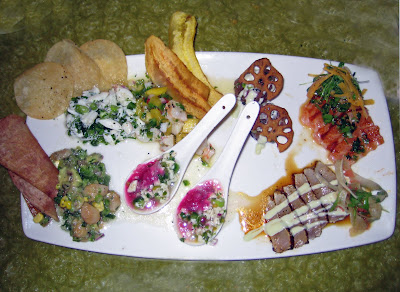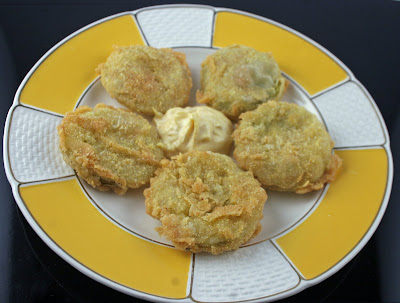Baltimore's Ultimate Exotic Dining Experience at BYOB
 In more active days of blogging at Unique Culinary Adventures, number one on my wish list was to score an invitation to the Explorers Club Annual Dinner in New York. From what I'd been able to read and learn, no other event on earth---even in places like China---offered as diverse an array of culinary exotica.
In more active days of blogging at Unique Culinary Adventures, number one on my wish list was to score an invitation to the Explorers Club Annual Dinner in New York. From what I'd been able to read and learn, no other event on earth---even in places like China---offered as diverse an array of culinary exotica.So it is extremely exciting that right here in old Bawlmer we now have Corner BYOB's Gastronaut Society. With the modest $50 membership comes a switchblade carving knife as well as the opportunity to participate in not just one, but three very unusual dinners a year. Kudo's to Chef Bernard and everyone at Corner BYOB at the northeast corner of 36th and Roland for taking the inititative to host these events.
Our title image pictures the head of a Lexington Market (Faidley's) procured raccoon. Other parts of it were principal ingredients in a stew that would be one of three items in our sixth---seventh if you count a prelinary kangaroo carpaccio amusant--- course of the evening. Ultimately, this raccoon head was to far exceed its pictured role as a candle holder.
 The first main course of our dinner was a platter bearing fried crickets and fried python snake meat with Harissa aoli. The crickets were from Thailand. We were instructed to pick them up by the legs and ingest their fried up but mushy heads and bodies, then discard the legs, which could tend to become caught in one's teeth. Far more than the crickets, I enjoyed the python a great deal, even though just about all amphibians taste pretty much alike: somewhere between chicken and fish, only somewhat tougher.
The first main course of our dinner was a platter bearing fried crickets and fried python snake meat with Harissa aoli. The crickets were from Thailand. We were instructed to pick them up by the legs and ingest their fried up but mushy heads and bodies, then discard the legs, which could tend to become caught in one's teeth. Far more than the crickets, I enjoyed the python a great deal, even though just about all amphibians taste pretty much alike: somewhere between chicken and fish, only somewhat tougher.The next plate bore sea urchin souffle with bay scallops and squid ink pasta. Most
 important was that the sea urchin was fresh, a far cry in taste and flavor from the uni served in typical Japanese restaurants. Fresh sea urchin---never mind that it's the creature's male sex organs---has a sublime mild flavor. By expanding our portions into souffle, Chef Bernard rendered them yet milder and impossible not to like. Even so, the fresh sea urchin all by itself would have suited me just fine. Everyone also loved the squid ink pasta with it's ever so light, mild, and not at all fishy flavor. Though bay scallops are hardly exotic, having some good fresh ones on hand, Chef Bernard apparently threw them in.
important was that the sea urchin was fresh, a far cry in taste and flavor from the uni served in typical Japanese restaurants. Fresh sea urchin---never mind that it's the creature's male sex organs---has a sublime mild flavor. By expanding our portions into souffle, Chef Bernard rendered them yet milder and impossible not to like. Even so, the fresh sea urchin all by itself would have suited me just fine. Everyone also loved the squid ink pasta with it's ever so light, mild, and not at all fishy flavor. Though bay scallops are hardly exotic, having some good fresh ones on hand, Chef Bernard apparently threw them in. Third course was balut accompanied by an Asian barbecue sauce. Balut is a popular street food in various Asian countries. That its preparation can differ somewhat from country to country is notable when considering just exactly what balut really is. Wikipedia provides an apt description. The word at at my table was that to have previously read the Wikipedia description could detract from the extent that some might enjoy their balut. Notwithstanding, everyone appeared to partake, some more than others. There was plenty of egg-white, which was brownish in colour. The rest tasted to me pretty much like duck liver.
Third course was balut accompanied by an Asian barbecue sauce. Balut is a popular street food in various Asian countries. That its preparation can differ somewhat from country to country is notable when considering just exactly what balut really is. Wikipedia provides an apt description. The word at at my table was that to have previously read the Wikipedia description could detract from the extent that some might enjoy their balut. Notwithstanding, everyone appeared to partake, some more than others. There was plenty of egg-white, which was brownish in colour. The rest tasted to me pretty much like duck liver.Next came a plate bearing separate portions of razor clams, fresh water eel, and fresh fava beans. Razor clams are frequently available in the Baltimore area at various Asian markets extending along Route 40 from about a mile inside the Beltway to west of Ellicott City. If you like maninose (soft-shell) clams, you'll like razor clams. They appeared to
 have been steamed in the shell, with appropriately flavored butter. The fresh water eel was delicious, mild and unlike any other variety of eel I'd previously enjoyed. As for the fresh fava beans, let them speak for themselves: so much work to prepare and so delectable.
have been steamed in the shell, with appropriately flavored butter. The fresh water eel was delicious, mild and unlike any other variety of eel I'd previously enjoyed. As for the fresh fava beans, let them speak for themselves: so much work to prepare and so delectable.Course number five consisted of a squid ink baguette, a spoon full of snail caviar,
 and a mini pancake on which to spread the caviar. People raved about the squid ink baguette, which was very mild. The caviar mystified me.Having once earned a (very meager) livelihood from producing canned chowders, one made from conch another from whelk, each a variety of sea snail, I'd never encountered snail caviar. Chef Bernard informed us, is made from the eggs of a snail that lives on land. It looked and tasted to me very much like trout caviar, a favorite of mine.
and a mini pancake on which to spread the caviar. People raved about the squid ink baguette, which was very mild. The caviar mystified me.Having once earned a (very meager) livelihood from producing canned chowders, one made from conch another from whelk, each a variety of sea snail, I'd never encountered snail caviar. Chef Bernard informed us, is made from the eggs of a snail that lives on land. It looked and tasted to me very much like trout caviar, a favorite of mine. And with our final main course came the raccoon stew, served with a side of trumpet mushrooms, a side of ravioli made with several other kinds of wild mushrooms, and oddly, a carrot. Having previously enjoyed trumpet mushrooms and various mushroom raviolis, my focus zeroed in on the raccoon, which would be yet another first for me. Stewed for long enough to be quite
And with our final main course came the raccoon stew, served with a side of trumpet mushrooms, a side of ravioli made with several other kinds of wild mushrooms, and oddly, a carrot. Having previously enjoyed trumpet mushrooms and various mushroom raviolis, my focus zeroed in on the raccoon, which would be yet another first for me. Stewed for long enough to be quite  well done, it's flavor was more neutral than I expected, despite a faint and very welcome gamey aftertaste. As for the severed head featured in our title picture? It was now that things---at another table---got pretty wild when a diner split it open, and before injesting the eyeballs, chowed down on the brains, which he described as tasting like yogurt. How sweet it was to be dining in a group where someone else proved more adventurous.
well done, it's flavor was more neutral than I expected, despite a faint and very welcome gamey aftertaste. As for the severed head featured in our title picture? It was now that things---at another table---got pretty wild when a diner split it open, and before injesting the eyeballs, chowed down on the brains, which he described as tasting like yogurt. How sweet it was to be dining in a group where someone else proved more adventurous. Last came desert for which everyone, curiously, still had room. If a bit anticlimatic, whole hibiscus flowers stuffed with goat cheese, everyone enjoyed it. A little over two hours had passed. We were full and happy. I learned that Corner BYOB would be serving this same dinner for more Gastronaut Society members the following night. The next dinner will be in the fall. Corner BYOB promises to announce its menu and a date by summer's end.
Last came desert for which everyone, curiously, still had room. If a bit anticlimatic, whole hibiscus flowers stuffed with goat cheese, everyone enjoyed it. A little over two hours had passed. We were full and happy. I learned that Corner BYOB would be serving this same dinner for more Gastronaut Society members the following night. The next dinner will be in the fall. Corner BYOB promises to announce its menu and a date by summer's end.



 SECOND PLACE: Stuffed Oyster Stickers
SECOND PLACE: Stuffed Oyster Stickers
















